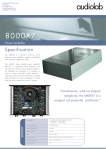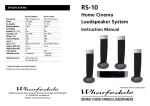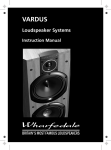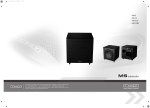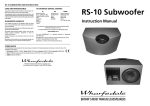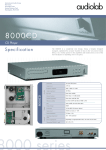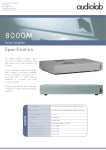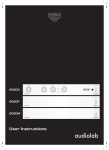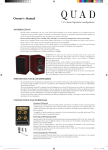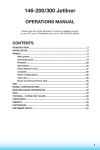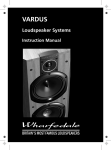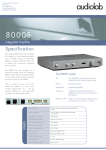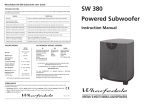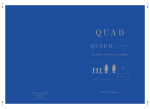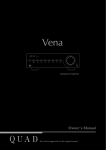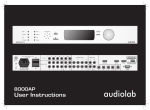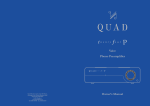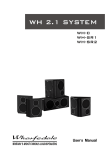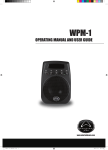Download Manual - Audio Visual Revolution
Transcript
User Instructions 8000X7 audiolab Audiolab IAG House, Sovereign Court, Ermine Business Park, Huntingdon Cambs PE29 6XU Tel: 01480 447700 Fax: 01480 431767 9: Warranty Audiolab limited warranty Audiolab Ltd. warrants this product, subject to the terms and conditions below, to be free from defects in materials and workmanship. During the warranty period Audiolab will repair or replace (at Audiolab's option) this product, or any defective part in this product, if it is found to be defective due to faulty materials, workmanship or function. The warranty period may vary from country to country. Terms and conditions: The warranty starts on the date of purchase (or the date of delivery if this is later). You must provide proof of purchase / delivery before work can be carried out. Without this proof, any work carried out will be chargeable to you. All work will be carried out by Audiolab or its authorised agents or distributors. Any unauthorised repair or modification will void this warranty. If any part is no longer available it will replaced with a functional replacement part. Any parts that are replaced will become the property of Audiolab. Any repair or replacement under this warranty will not extend the period of warranty. This warranty is valid only in the country of purchase, applies only to the first purchaser and is not transferable. The following are not covered: ! ! ! ! ! ! Products on which the serial number has been removed, altered or otherwise made illegible. Normal wear and tear and cosmetic damage. Transportation or installation of the product. Accidental damage, faults caused by commercial use, acts of God, incorrect installation, connection or packaging, misuse, neglect or careless operation or handling of the product which is not in accordance with Audiolab's user instructions. Equipment that has been operated in conjunction with unsuitable, inappropriate or faulty apparatus. Repairs or alterations carried out by parties other than ! ! ! Audiolab or its authorised agents or distributors. Products not purchased from an Audiolab authorised dealer. Products that were not new at the time of original purchase. Products sold 'as is', 'as seen' or 'with all faults'. Repairs or replacements as provided under this warranty are the exclusive remedy of the consumer. Audiolab shall not be liable for any incidental or consequential damages for breach of any express or implied warranty in this product. Except to the extent prohibited by law, this warranty is exclusive and in lieu of all other warranties whatsoever, both express and implied, including, but not limited to, the warranty of merchantability and fitness for a practical purpose. This warranty provides benefits that are additional to and do not affect your statutory rights as a consumer. Some countries and US states do not allow the exclusion or limitation of incidental or consequential damages or implied warranties so the exclusions in the paragraph above may not apply to you. This warranty gives you specific legal rights, and you may have other statutory rights, which vary from state to state or country to country. How to claim: To obtain warranty service contact the Audiolab authorised dealer from which you purchased this product. Do not despatch goods without the prior agreement of the dealer, Audiolab or their authorised distributors. If asked to return products for inspection and/or repair, pack carefully, preferably in the original cartons or packaging affording an equal degree of protection, and return prepaid. If unsuitable packaging is used, Audiolab may make a charge for the supply of new packaging. Insurance is recommended as goods are returned at owner's risk. Audiolab or their authorised distributors cannot be held liable for loss or damage in transit. Packing, insurance and freight on the return journey will be paid by Audiolab or their authorised agents or distributor if corrective work proves to be necessary. 1: Statutory & Safety Information CAUTION! Use only attachments/accessories specified by the manufacturer. Use only with a cart, stand, tripod, bracket, or table specified by the manufacturer, or sold with the apparatus. When a cart is used, use caution when moving the cart/apparatus combination to avoid injury from tip-over. RISK OF ELECTRIC SHOCK DO NOT OPEN TO REDUCE THE RISK OF ELECTRIC SHOCK DO NOT REMOVE COVER NO USER-REMOVEABLE PARTS INSIDE REFER SERVICING TO QUALIFIED PERSONNEL ADVERTISSEMENT: RISQUE DE CHOC ELECTRIQUENE PAS OUVRIR This symbol indicates that there are important operating and maintenance instructions in the literature accompanying this unit. This symbol indicates that dangerous voltage constituting a risk of electric shock is present within this unit. Read these instructions. Keep these instructions. In the event that you pass the product to a third party this instruction manual should be provided along with the product. Heed all warnings. Follow all instructions. Do not use this apparatus near water. Clean only with dry cloth. Do not block any ventilation openings. Install in accordance with the manufacturer's instructions. Do not install near any heat sources such as radiators, heat registers, stoves, or other apparatus (including amplifiers) that produce heat. Do not defeat the safety purpose of the polarized or grounding type plug. A polarized plug has two blades with one wider than the other. A grounding type plug has two blades and a third grounding prong. The wider blade or the third prong are provided for your safety. If the provided plug does not fit into your outlet, consult an electrician for replacement of the obsolete outlet. Protect the power cord from being walked on or pinched, particularly at plugs, convenience receptacles, and the point where they exit from the apparatus. Unplug this apparatus during lightning storms or when unused for long periods of time. Refer all servicing to qualified service personnel. Servicing is required when the apparatus has been damaged in any way, such as powersupply cord or plug is damaged, liquid has been spilled or objects have fallen into the apparatus, the apparatus has been exposed to rain or moisture, does not operate normally, or has been dropped. Warning: To reduce the risk of fire or electrical shock, do not expose this product to rain or moisture. The product must not be exposed to dripping and splashing and no object filled with liquids such as a vase of flowers should be placed on the product. No naked flame sources - such as candles - should be placed on the product. Caution: Changes or modifications not expressly approved by the manufacturer could void the user's authority to operate this device. This equipment has been tested and found to comply with the limits for a Class B digital device, pursuant to part 15 of the FCC rules. These limits are designed to provide reasonable protection against harmful interference in a residential installation. This equipment generates, uses and can radiate radio frequency energy and, if not installed and used in accordance with the instructions, may cause harmful interference to radio or television reception, which can be determined by tuning the equipment off and on, the user is encouraged to try to correct the interference by one or more of the following measures: Re-orientate or re-locate the receiving antenna. Increase the separation between the equipment and the receiver. Connect the equipment into an outlet on a circuit different from that to which the receiver is connected. Consult the dealer or an experienced radio/TV technician for help. 7: Specifications Power Output or or 7 x 100W into rated load impedance (8 Ω) 5 x 100W and 1 x 150W (8 Ω) 3 x 100W and 2 x 150W (8 Ω) Input for rated power 1.05 Vrms Gain (at 1 kHz) Input Impedance Signal to Noise Ratio Frequency response ( -3 dB ) Class II construction double insulated. These products must not be connected to earth. Power Cord: An AC power cord is normally supplied with a mains plug suitable for your area. If you have any doubts, consult your dealer about obtaining a suitable power cord. Important notice to UK users The appliance cord is terminated with a UK approved mains plug fitted with a 13A fuse. If the fuse needs to be replaced, an ASTA or BSI approved BS1362 fuse rated at 10A must be used. If you need to change the mains plug, remove the fuse and dispose of this plug safely immediately after cutting it from the cord. Connecting a Mains Plug The wires in the mains lead are coloured in accordance with the code: red: NEUTRAL; Brown: LIVE: As these colours may not correspond to the coloured markings identifying the terminals in your plug, proceed as follows: The red wire must be connected to the terminal marked with the letter N or coloured red or BLACK. The BROWN wire must be connected to the terminal marked with the letter L or coloured BROWN or RED. 10A FUSE BS 1362 red (Neutral) Care & Cleaning While cleaning is in progress the AC power cord must be unplugged from the AC power supply socket. Grease or dirt on the equipment may be removed with a soft, lint-free cloth slightly moistened with a mild solution of warm water and detergent or washing-up liquid. Do not use any other solutions or solvents. 47kΩ Servicing better than 90 dB (relative to 0 dBW) unweighted Servicing of Audiolab products should only be carried out by authorised service agents. If service is required the equipment should be returned, securely packaged, preferably using original packaging, to your dealer. 1.5 Hz - 150 kHz AC Supply Voltage 110 – 120 V or 220 – 240 V The voltage is marked on the rear of the unit Standby <5VA, max 1500VA 445 mm wide x 130 mm high x 340 mm deep (including feet, terminals and controls) BROWN (Live) 8: Service If you have any queries regarding the use of Audiolab equipment, consult your dealer. 10 - 35°C Dimensions Overall (WxHxD) Mains Supply: The mains voltage of Audiolab units is shown on the rear panel. If this does not match the voltage in your area, consult your dealer. The mains supply fuse is on the rear panel. If it has broken, check for any obvious cause before replacing the fuse with one of the correct rating and type. The fuses for all areas are type T (time lag ) AL 20mm. The fuse values are: 220-240V:10.0A`100-120V: 1 5A The fuse is located in a slide-in Fuse Carrier carrier which also contains a spare fuse. The carrier can only be pulled out after the IEC power cord is unplugged. When the carrier is opened the first fuse is the spare. Remove and safely dispose of the blown fuse before replacing it. IEC Mains Connector 28.8dB Operating temperature range Power Consumption Mains supply and safety In the UK equipment may be returned to the IAG Service Centre. In the USA equipment may be returned to the Service address shown on this page. Always telephone before returning any equipment. A note should be enclosed giving your name, address, telephone number, and a brief description of the reason for return. If you require Service outside the Warranty period, do not hesitate to contact your dealer. Service Address - UK IAG Service Centre Unit 4 St Margaret’s Way Stukeley Meadows Industrial Estate Huntingdon Cambs PE29 6EB England Tel:+44 (0)1480 452561 Fax: +44 (0)1480 13403 Service Address - USA IAG America, Inc. 15 Walpole Park South Walpole MA 02081 USA Tel: +1 508 850 3950 Fax +1 508 850 3905 6: Operation Switching On Protection Modes Connect the mains cable to the amplifier, and then switch on at the wall socket. The red power LED will glow dimly to indicate that power is applied but the amplifier is in the standby state. In this condition the loudspeakers are disconnected by the internal muting relays and power is removed from the amplifier circuitry. If the standby mode switch on the rear is set to ‘ALWAYS ON’ (right position), after a short delay the amplifier will go to the active state and the red power LED will glow brightly. In the two other positions the amplifier will remain in standby until it receives an audio signal of sufficient amplitude, or a trigger voltage from the AV processor is applied to the rear jack socket. This switch may be freely operated when the unit is powered. If the amplifier needs to protect itself against abnormal conditions, it will go into standby, and disconnect the loudspeakers. It will then attempt to re-enter the active state after a short delay. If the abnormal conditions persist, after the third attempt the amplifier will stay in standby indefinitely until manually reset by removing and reinserting the mains cable. Short-term overload protection: Sustained short-circuit, overload or heavy clipping in any channel will send the unit into standby. After a few seconds the unit will attempt to activate. After three attempts the amplifier will stay indefinitely in standby. Remove the mains plug, wait a short time and reinsert the plug. Overload protection signal: Power LED dim with one bright flash every second. Over-temperature protection: Overheating within the amplifier as a result of blocked ventilation slots or other abnormal conditions will send the unit into standby. After three attempts to re-activate the amplifier will stay indefinitely in standby. Remove the mains plug, wait for the amplifier to cool down completely and re-insert the plug. Audio Signal Activation If the Standby Mode switch on the rear is set to ‘HIGH SENSITIVITY’ (middle position) and there is no external trigger voltage, the amplifier will remain in standby until an audio signal is applied. It will then become active and the red power LED will glow brightly. The amplifier will remain active for 15 minutes after all audio signals have ceased and will then return to standby. This delay prevents the amplifier going to standby during brief programme interruptions e.g while changing discs. Over-temperature signal: Power LED dim with two bright flashes every second. DC offset protection: Caused by internal amplifier fault or a large DC input signal. The unit will go into standby. After a few seconds the unit will attempt to activate. After three attempts the amplifier will stay indefinitely in standby. Remove the mains plug, wait a short time and re-insert the plug. If the standby mode switch is set to ‘LOW SENSITIVITY’, operation is as for high sensitivity except that the incoming audio signal must be at a higher level before the unit switches on. Use this setting in electrically noisy environments if there are problems with spurious activation, especially if the amplifier is operated in a 5 or 6 channel configuration and the outputs are not bridged. Refer to Section 5. It is most unlikely you will ever see this indication; if you do unplug the amplifier at once and arrange for it to be checked by competent service personnel. Trigger Activation Phase When the AV processor is activated the processor’s trigger circuit sends a pulse to the 8000X7. After a short delay the amplifier will go to the active state and the red power LED will glow brightly. (See section 3) If the amplifier is set to ‘Always On’, the trigger switch has no effect. It is essential that the loudspeaker connections are secure and with the positive and negative terminals correctly connected. DC offset protection signal: Power LED dim with three flashes every second. This becomes especially important in multi-channel systems where the effects of one or more incorrectly connected (out of phase) loudspeakers may severely impair the sound and yet be difficult to detect. If the sound appears muddled and lacking clarity this may be because one or more speaker connections are not correctly made. Always check loudspeaker connections carefully when you have made any alteration to your system. 2: Introduction FRONT SPEAKER TERMINALS FRONT SIGNAL INPUTS Introduction The Audiolab 8000X7 is a seven channel power amplifier of impeccable specification. In 7-channel configuration it produces 100W of continuous power into 8 Ohms on all channels. The amplifier can be readily configured to provide five channels of 100W and one channel of 150W (6 ch. set-up), or three channels of 100W and two channels of 150W (5 ch set-up). The amplifier can be set up so that it switches itself to a standby mode when not in use to minimise power consumption. It returns from standby to active on receiving a signal input or external trigger; alternatively it can be set to stay permanently active. The 8000X7 includes comprehensive but completely unobtrusive protection against overload, excessively prolonged clipping, DC offsets, and high temperatures. The 8000X7 has a sophisticated muting system, which stops you hearing loud, annoying switching noises and protects the amplifier and the loudspeakers. Particular care has been taken to make sure that the muting MAINS INPUT AND FUSE STANDBY MODE SWITCH TRIGGER INPUT EFFECTS SPEAKER TERMINALS CHANNEL BRIDGING SWITCH circuitry, when switched off, doesn’t affect the sound quality. For this purpose carefully selected relays with minimal crosstalk between coil and contacts have been used. Unpacking Unpack the product fully. The carton should contain: ( The Audiolab 8000X7 EFFECTS SIGNAL INPUTS Positioning The 8000X7 dissipates large amounts of heat when operating. ( Place the 8000X7 on an open, level and sturdy flat surface. ( Avoid operating the amplifier on a soft surface, such as thick carpet, which could block ventilation slots under the unit. ( Please ensure that there is adequate ventilation above and below the ( One IEC power cord suitable for your area ( This instruction manual Report any damage or shortage to your dealer as soon as possible. Retain the packing if possible. If you dispose of the packing, do so with regard to any recycling regulations in your area. Please retain this User Manual. In the unlikely event that you pass your 8000X7 on to a third party, please include this manual. ( ( unit. It is important that the cooling slots in the top and bottom are not obstructed, and there is sufficient space around the unit to allow for the free circulation of air. Do not use in a cabinet or other confined space. Do not place any equipment on top of the amplifier. Controls The 8000X7 is designed for the simplest possible operation, and the only controls are two switches on the rear panel. One sets the standby mode and the other the channel bridging. There are no front panel controls. 3: Connections & Cables 4: Bridging Switch power off before making connections! Connecting Loudspeakers Connecting to an AV Processor Standard and Bridged Connections Switch power off before connecting loudspeakers. Use good quality low resistance loudspeaker cable. The left and right channel pairs should be connected with equal lengths of cable. Connect the Positive RED (+) terminal of the amplifier to the Positive (+) RED terminal of the loudspeaker. Connect the Negative (-) BLACK terminals similarly. Tighten the loudspeaker terminals securely by hand. Make there are no loose strands of wire which could cause shorts. You will require a preamplifier, or ideally a multichannel AV processor, such as the Audiolab 8000AV to provide the signals to drive the 8000X7. Bridging is a technique that enables two amplifiers to drive a single loudspeaker. When you balance the channel levels via the AV processor, the bridged channel/s will play at exactly the same level as all the other channels. 7mm Speaker Cables RED BLACK 20mm Each output should be connected to the matching input on the 8000X7. To connect the source equipment to the 8000X7, you should use a high quality, well screened RCA-RCA audio cable. Push the connectors fully home to secure a firm connection. All the RCA-RCA cables should be arranged so they are bundled as closely together as possible, especially at the rear of the amplifier. This minimises the chances of cable loops picking up magnetic fields and degrading performance. The 8000X7 can be configured for 5 channel, 6 channel or 7 channel applications depending on your AV processor. If you are in any doubt, consult your dealer. 8000X7 INPUT CONNECTIONS IN A CENTRE Connecting Cables LEFT RIGHT IN B BR SR A trigger gives you the option of switching the amplifier on and off every time the AV processor is switched on and off. Trigger and Sensitivity Settings for use with the Audiolab 8000AV When used with the 8000AV the trigger input should be connected. The control function is carried out by the 8000AV, and the 8000X7is the slave unit. The Sensitivity switch should be set to high when used with the 8000X7. 5c: 5-Channel Connections CENTRE 7 channels each of 100W are available. If your system has 6 or 5 channels, the unused channel/s can be safely left unconnected. Alternatively, the amplifier can be switched to provide extra power to one or more channels as described below. BL 6-Channel Mode: (BR+SR) SL This provides 5 channels of 100W and one bridged channel of 150W. The bridged channel should be used to drive the centre speaker as shown in Section 5b. NEVER OPERATE THE BRIDGING SWITCH WHEN THE AMPLIFIER IS SWITCHED ON. THE SUDDEN SURGE MAY DAMAGE YOUR SPEAKERS IRREPARABLY. To 8000AV Trigger See Section 6 for further information on the operation of the trigger. SIGNAL 7-Channel Mode: (OFF) This provides 3 channels of 100W and two bridged channels of 150W. The bridged channels should be used to drive the front left and right speakers. Refer to diagram 5c. If your AV processor has a trigger output, this should be connected to the trigger input of the 8000X7 via the 3.5mm jack socket. Your dealer will be able to supply you with a suitable interconnect. SPEAKER To use bridged modes of operation you must alter the position of the channel bridging slide switch on the rear of the unit. This has three positions- equivalent to 7-Channel, 6-Channel and 5-Channel operation. 5-Channel Mode: (BR+SR: BL+SL) Connecting the Trigger Set the Channel Bridging Switch to BR+SR/BL+SL Note: These matching levels will be maintained regardless of the setting of the master volume control. However, more power is available at the bridged output to provide a cleaner, punchier sound to the loudspeaker. Switch power off before making connections! REAR LEFT SIGNAL SPEAKER SIGNAL SPEAKER SPEAKER FRONT RIGHT FRONT LEFT SIGNAL SIGNAL SPEAKER REAR RIGHT FRONT LEFT 8000X7 5-Channel Connections ( Ensure the power to the amplifier is OFF ( Switch the Channel Bridging Switch to the right position marked BR+SR/BL+SL. ( Connect the signal inputs to the appropriate channels of the AV amplifier. ( Connect the loudspeaker terminals to the correct speakers. FRONT RIGHT CENTRE SUB WOOFER For optimum performance, in 5-Channel configuration the Front Left and Front Right speakers are connected to the bridged amplifier channels and the other speakers are connected as shown in the diagram. Please note that these connections differ from the connections marked on the amplifier. ( Connect the +(RED) terminal of each amplifier channel to the corresponding + (RED) terminal of the loudspeaker. Connect the - (BLACK) terminal of each amplifier channel to the corresponding - (BLACK ) terminal of the loudspeaker. Ensure there are no loose strands of wire that can short the terminals out. REAR SURROUND LEFT REAR SURROUND RIGHT 5b: 6-Channel Connections Switch power off before making connections! FRONT LEFT Set the Channel Bridging Switch to BR+SR SPEAKER SIGNAL BACK SURROUND RIGHT CENTRE SIGNAL SPEAKER SIGNAL SPEAKER SPEAKER SIGNAL SIGNAL SPEAKER SIGNAL SPEAKER SURROUND LEFT FRONT RIGHT FRONT LEFT 8000X7 6-Channel Connections ( Ensure the power to the amplifier is OFF ( Switch the Channel Bridging Switch to the middle position marked “BR+SR” ( Connect the signal inputs to the appropriate channels of the AV amplifier. ( Connect the loudspeaker terminals to the correct speakers. FRONT RIGHT CENTRE SUB WOOFER Although the bridged channel can be used for the Back channel, a better use is to connect the Centre channel speaker (and the Centre channel output from the AV processor) to this channel and connect the Back speaker (and the Back channel output from the AV processor) to the Centre channel output. The suggested connections are shown on the diagram. SURROUND LEFT SURROUND RIGHT Please note that these connections differ from the connections marked on the amplifier. ( Please follow the diagram carefully so as to connect your speakers correctly. BACK 5a: 7-Channel Connections Switch power off before making connections! FRONT LEFT Set the Channel Bridging Switch to OFF BACK RIGHT SIGNAL SPEAKER SIGNAL SPEAKER SPEAKER SPEAKER SPEAKER SIGNAL CENTRE FRONT RIGHT BACK LEFT SIGNAL SIGNAL SPEAKER SIGNAL SIGNAL SPEAKER SURROUND RIGHT SURROUND LEFT FRONT LEFT 8000X7 7-Channel Connections ( Ensure the power to the amplifier is OFF ( Switch the Channel Bridging Switch to OFF ( Connect the signal inputs to the appropriate channels of the AV amplifier. ( Connect the loudspeaker terminals to the correct speakers. Refer to the drawing at the bottom right of this page for guidance. ( Connect the +(RED) terminal of each amplifier channel to the corresponding + (RED) terminal of the loudspeaker. Connect the - (BLACK) FRONT RIGHT CENTRE SUB WOOFER SURROUND LEFT SURROUND RIGHT terminal of each amplifier channel to the corresponding - (BLACK ) terminal of the loudspeaker. Ensure there are no loose strands of wire that can short the terminals out. BACK LEFT BACK LEFT






